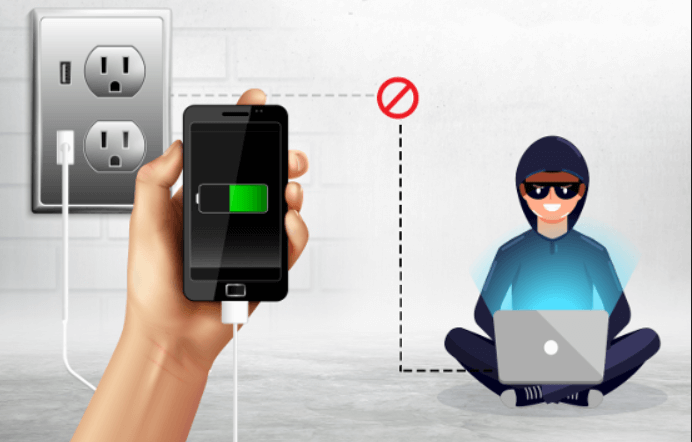Watch out for juice jacking! This USB charger fraud has the potential to bankrupt your bank account. In layman’s terms, it is a sort of cyberattack that uses USB charging ports that are put in public locations like airports, cafes, bus stops, etc. Never imagined that simply plugging in your phone at a charging station would put you at risk for a cyberattack?

A USB charging station that has been infected can be used to corrupt linked devices in a security exploit known as “juice jacking.” The vulnerability exploits the fact that a mobile device’s power supply travels over the same USB cable as the linked device’s data sync cable.
This means that if your battery is low, you should be aware that charging your electronic device at a free USB port, such as one located at an airport, hotel, shopping center, and other public location that offers free charging stations for mobile devices, you may be a victim of juice jacking.
However, the attack vector is real and frequently contrasted with older ATM card skimming exploits. Juice jacking and card skimming both depend on the end user believing the hacked gear is safe.
Get TikTok SEO Cheat here
How Juice Jacking works
A USB port is frequently employed as a data transfer medium. The data transfer is typically turned off by default on phones, and only the end that supplies power can see the connection. You can move documents, films, and other types of media back and forth from one computer to another using this method.
Juice jacking prevents the device owner from knowing what the USB port is connected to. Therefore, if someone is checking on the other end when the phone is connected in, they will be able to transfer data between your device and theirs.
4 Types of juice jacking attacks
1. Malware installation
The malware installed on the device as a result of malware installation juice-jacking attacks may cause significant harm, such as manipulating a phone or computer, spying on a user, locking the user out of the device, or stealing data.
2. Data theft
Users who are victims of data theft juice-jacking attacks are unaware that their private information has been taken. There is a chance that very significant amounts of data will be compromised, depending on how long a device is plugged into a compromised cable or port. Hackers might even be able to create a complete backup of the data on a device given enough time and storage capacity.
3. Multi-device attack
In addition to damaging the device hooked into a corrupted charger, a device powered by malware-infected cords may also unknowingly spread the virus to adjacent cables and ports.
4. Disabling attack
Some virus that is downloaded via a charging device might lock the owner out of their device, granting the hacker full access.
The two greatest risks of juice jacking
Data theft: When a device is plugged into a public USB port, a hacker can infect your plugged-in device by compromising the port. This can result in data theft from your mobile device. Using a crawler tool, the cybercriminal can then look for financial information or other sensitive information on your device. It is possible to impersonate you or access your financial information using this personal information.
Malware installation: Cybercriminals can copy your phone’s data and transfer it to their own smartphone via malware apps. This could consist of phone logs, purchases, photographs, and GPS position. Your gadget can potentially be frozen by the hacker, who may then demand money to unlock it.
Best Ways to protect against juice jacking
- Avoid using portable wall chargers or public charging stations; instead, plug your phone into an electrical wall outlet. Only bring and use your own cords.
- Employ software security measures. To prevent pairing with a linked device, constantly lock your phone.
- Turning off your smartphone before charging it is a different suggestion. As the device’s flash storage might then be connected to the USB port.
- Select a different charging method for your phone: These alternatives include external batteries or power banks.
- Make use of USB pass-through devices: These charging-only adapters let electricity pass through but disable the USB charger’s data pin.This indicates that no data transfers will be possible while the device is charging.

Read Also:
- How to Find Deleted Texts on Your Husband’s/Wife’s Phone
- Free Data Code For All Network 2023| 50GB, 30GB, 10GB, 5gb, 4gb, 1gb
- 20 Best Free Cooking Apps for Both Nigerian and Foreign Dishes
Wrapping it Up
Try to implement the use of Touch ID, Face ID, or passcode entry to activate data connections via the Lightning, USB, or Smart Connector interface.
By doing so, malicious chargers and other physically attached devices are less vulnerable to attack, but other accessories can still be used within realistic time limitations.
Hackers are constantly looking for fresh and inventive ways to compromise systems, as we are all aware. Juice jacking is a serious issue that shouldn’t be disregarded, whether the perpetrators’ intention is to access their companies’ networks or to steal the personal information of their victims.
We’re taking the time to alert you to this threat because of this. In order for you to inform not only yourself but also the management and staff of your company.